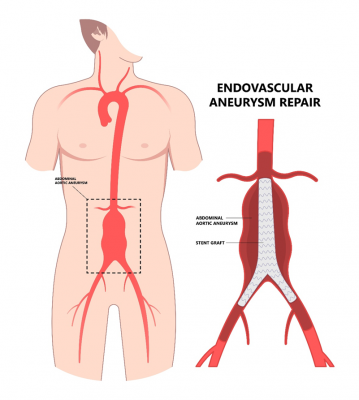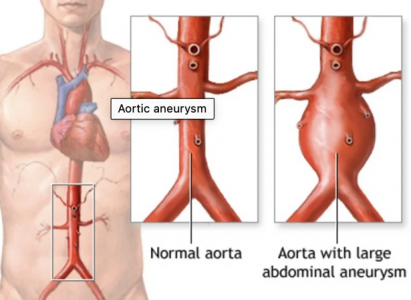An abdominal aortic aneurysm also known as a AAA occurs in the lower part of your aorta, this is your body’s major artery. They grow at different rates and can present with symptoms such as new onset back or abdominal pain and/or a pulsating sensation near your belly button.
An aneurysm is a weakness in any artery wall of the body and over time this weakness causes a bulge or dilation. This most commonly occurs in the aorta below the kidney arteries before the aorta splits into two. The problem with aneurysms is they are like a balloon the bigger they get the more likely they are to rupture. A ruptured aneurysm is a life-threatening emergency. Once an aneurysm is discovered (often incidentally while scanning for unrelated conditions) it needs to be monitored until it reaches a size when it should be repaired in a planned fashion. Some aneurysms may never reach a size that requires surgery.
Aneurysms in the abdomen are also associated with aneurysms behind the knee, called Popliteal aneurysms. Popliteal aneurysms behave a little differently, the larger they get rather than bursting they tend to block suddenly. This causes the leg below that to lose blood supply which is a surgical emergency. For this reason, any time a patient is found with a new AAA Dr. McGlade will organise a scan to check for aneurysms behind the knee.
Because there can be an association with family members having aneurysms, guidelines recommend that any of your first-degree relatives are checked for aneurysms between the age of 60 and 65. This can be done with an ultrasound organised by their local doctor. If an aneurysm is found then a vascular review is warranted, however if no aneurysm is seen then there is no need for ongoing surveillance. AAA’s usually develop later in life and screening from the age of 60 is appropriate.
Aneurysm surgery is a sub specialty interest area of Dr McGlade. He has developed advanced skills in both open and minimally invasive techniques of aneurysm repair. In your initial consultation he will perform a thorough history and examination. He will then take the time to explain to you and your family causes of aneurysms and the indications for repair or continued surveillance.
. He will also discuss other factors relevant to the new diagnosis of an aneurysm such as further screening which includes behind the knee, chest and family screening and medical management. Medical management includes implementing blood pressure control and prescribe medications to decrease the risk from arterial disease. And most importantly answer any questions or concerns you have about your diagnosis.







